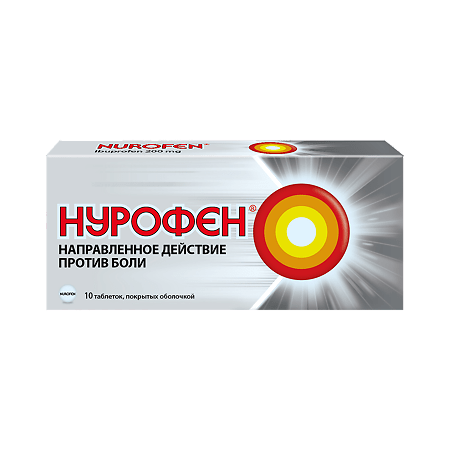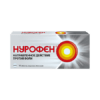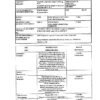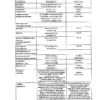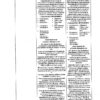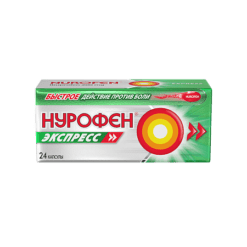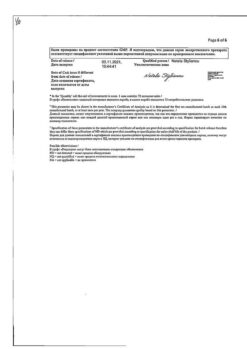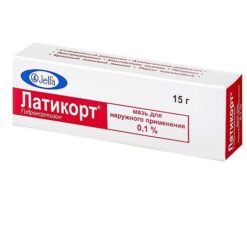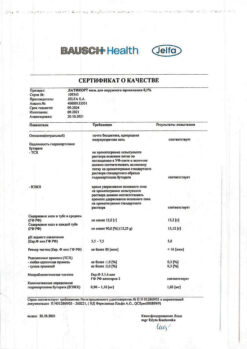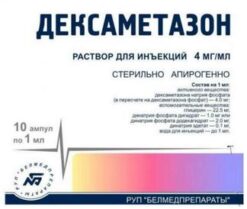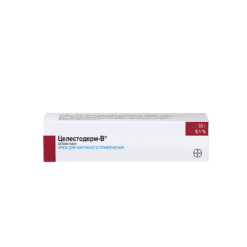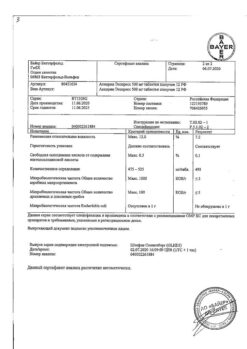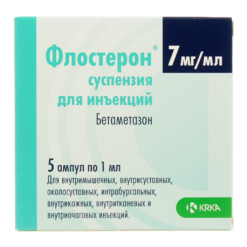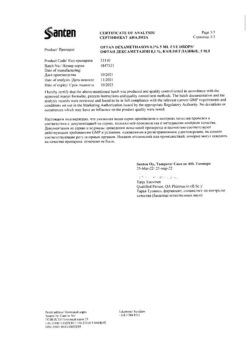No products in the cart.
Nurofen, 200 mg 10 pcs
€3.88 €3.53
Description
The mechanism of action of ibuprofen, a derivative of propionic acid from the group of non-steroidal anti-inflammatory drugs (NSAIDs), is due to inhibition of prostaglandin synthesis mediators of pain, inflammation and hyperthermia.
Indiscriminately blocks cyclooxygenase 1 (COX-1) and cyclooxygenase 2 (COX-2), thereby inhibiting prostaglandin synthesis. It has a fast directed action against pain (analgesic), antipyretic and anti-inflammatory effect. In addition, ibuprofen reversibly inhibits platelet aggregation. The analgesic effect of the drug lasts up to 8 hours.
Pharmacokinetics
Absorption is high, quickly and almost completely absorbed from the gastrointestinal tract (GIT). After taking the drug on an empty stomach the maximum concentration (Cmax) of ibuprofen in blood plasma is reached after 45 minutes. If the drug is taken with food it may increase the time to reach the maximum concentration (Òcmax) up to 1-2 hours.
Binding with blood plasma proteins is 90%. Slowly penetrates into the joint cavity, stays in synovial fluid, creating higher concentrations in it than in blood plasma. Lower concentrations of ibuprofen are found in cerebrospinal fluid compared to blood plasma. After absorption about 60% of pharmacologically inactive R-form is slowly transformed into active S-form. It is metabolized in the liver. The half-life (T1/2) is 2 hours. It is excreted by the kidneys (not more than 1% unchanged) and, to a lesser extent, with bile.
In limited studies ibuprofen was detected in breast milk in very low concentrations.
Indications
Indications
Headache;
migraine;
toothache/condition after tooth extraction;
neuralgia;
myalgia and arthralgia;
mild to moderate musculoskeletal injuries;
rheumatic pains;
algodismenorrhea;
cold and flu symptoms;
fever of various origins.
Pharmacological effect
Pharmacological effect
The mechanism of action of ibuprofen, a derivative of propionic acid from the group of non-steroidal anti-inflammatory drugs (NSAIDs), is due to inhibition of the synthesis of prostaglandins, mediators of pain, inflammation and hyperthermic reaction.
Indiscriminately blocks cyclooxygenase 1 (COX-1) and cyclooxygenase 2 (COX-2), as a result of which it inhibits the synthesis of prostaglandins. It has a rapid, targeted effect against pain (analgesic), antipyretic and anti-inflammatory effects. In addition, ibuprofen reversibly inhibits platelet aggregation. The analgesic effect of the drug lasts up to 8 hours.
Pharmacokinetics
Absorption is high, quickly and almost completely absorbed from the gastrointestinal tract (GIT). After taking the drug on an empty stomach, the maximum concentration (Cmax) of ibuprofen in the blood plasma is reached after 45 minutes. Taking the drug with food may increase the time to reach maximum concentration (TCmax) by up to 1-2 hours.
Connection with blood plasma proteins 90%. Slowly penetrates into the joint cavity, lingers in the synovial fluid, creating higher concentrations in it than in the blood plasma. Lower concentrations of ibuprofen are found in cerebrospinal fluid compared to blood plasma. After absorption, about 60% of the pharmacologically inactive R-form is slowly transformed into the active S-form. Metabolized in the liver. Half-life (T1/2) 2 hours. Excreted by the kidneys (no more than 1% unchanged) and, to a lesser extent, with bile.
In limited studies, ibuprofen has been found in breast milk at very low concentrations.
Active ingredient
Active ingredient
Ibuprofen
Composition
Composition
Active substance:
ibuprofen – 200 mg.
Excipients:
croscarmellose sodium – 30 mg,
sodium lauryl sulfate – 0.5 mg,
sodium citrate dihydrate – 43.5 mg,
stearic acid – 2 mg,
colloidal silicon dioxide – 1 mg.
Shell composition:
carmellose sodium – 0.7 mg, talc – 33 mg, acacia gum – 0.6 mg, sucrose – 116.1 mg, titanium dioxide – 1.4 mg, macrogol 6000 – 0.2 mg, black ink (Opacode S-1-277001) (shellac – 28.225%, iron dye black oxide (E172) – 24.65%, propylene glycol – 1.3%, isopropanol* – 0.55%, butanol* – 9.75%, ethanol* – 32.275%, purified water* – 3.25%).
Contraindications
Contraindications
Hypersensitivity to ibuprofen or any of the components included in the drug.
Complete or incomplete combination of bronchial asthma, recurrent polyposis of the nose and paranasal sinuses and intolerance to acetylsalicylic acid or other NSAIDs (including a history).
Erosive and ulcerative diseases of the gastrointestinal tract (including gastric and duodenal ulcers, Crohn’s disease, ulcerative colitis) or ulcerative bleeding in the active phase or in history (two or more confirmed episodes of peptic ulcer or ulcerative bleeding).
A history of bleeding or perforation of a gastrointestinal ulcer caused by the use of NSAIDs.
Severe heart failure (NYHA class IV – New York Heart Association classification)
Severe liver failure or active liver disease.
Severe renal failure (creatinine clearance
30 ml/min), confirmed hyperkalemia.
Decompensated heart failure; period after coronary artery bypass surgery.
Cerebrovascular or other bleeding.
Fructose intolerance, glucose-galactose malabsorption, sucrase-isomaltase deficiency.
Hemophilia and other bleeding disorders (including hypocoagulation), hemorrhagic diathesis.
Pregnancy (III trimester).
Children’s age up to 6 years.
Side Effects
Side Effects
The risk of side effects can be minimized if the drug is taken in a short course, at the minimum effective dose required to eliminate symptoms.
Elderly people experience an increased incidence of adverse reactions with NSAID use, especially gastrointestinal bleeding and perforation, in some cases fatal.
Side effects are predominantly dose dependent.
The following adverse reactions were observed with short-term use of ibuprofen in doses not exceeding 1200 mg/day (6 tablets).
When treating chronic conditions and with long-term use, other adverse reactions may occur.
The frequency of adverse reactions was assessed based on the following criteria: very common (1/10), common (1/100 to 1/10), uncommon (1/1000 to 1/100), rare (1/10,000 to 1/1000), very rare (1/10,000), frequency unknown (insufficient data to estimate frequency).
Blood and lymphatic system disorders
Very rare: hematopoietic disorders (anemia, leukopenia, aplastic anemia, hemolytic anemia, thrombocytopenia, pancytopenia, agranulocytosis). The first symptoms of such disorders are fever, sore throat, superficial ulcers in the mouth, flu-like symptoms, severe weakness, nosebleeds and subcutaneous hemorrhages, bleeding and bruising of unknown etiology.
Immune system disorders
Uncommon: hypersensitivity reactions, nonspecific allergic reactions and anaphylactic reactions, reactions from the respiratory tract (bronchial asthma, including its exacerbation, bronchospasm, shortness of breath, dyspnea), skin reactions (itching, urticaria, purpura, Quincke’s edema, exfoliative and bullous dermatoses, including toxic epidermal necrolysis (Lyell’s syndrome), Stevens-Johnson syndrome, erythema multiforme), allergic rhinitis, eosinophilia.
Very rare: severe hypersensitivity reactions, including swelling of the face, tongue and larynx, shortness of breath, tachycardia, hypotension (anaphylaxis, angioedema or severe anaphylactic shock).
Gastrointestinal disorders
Uncommon: abdominal pain, nausea, dyspepsia (including heartburn, bloating).
Rare: diarrhea, flatulence, constipation, vomiting.
Very rare: peptic ulcer, perforation or gastrointestinal bleeding, melena, hematemesis, in some cases fatal, especially in elderly patients, ulcerative stomatitis, gastritis.
Frequency unknown: exacerbation of colitis and Crohn’s disease.
Disorders of the liver and biliary tract
Very rare: liver dysfunction, increased activity of liver transaminases, hepatitis and jaundice.
Renal and urinary tract disorders
Very rare: acute renal failure (compensated and decompensated), especially with long-term use, in combination with an increase in the concentration of urea in the blood plasma and the appearance of edema, hematuria and proteinuria, nephritic syndrome, nephrotic syndrome, papillary necrosis, interstitial nephritis, cystitis.
Nervous system disorders
Uncommon: headache.
Very rare: aseptic meningitis.
Cardiovascular system disorders
Frequency unknown: heart failure, peripheral edema, with long-term use increased risk of thrombotic complications (for example, myocardial infarction), increased blood pressure.
Disorders of the respiratory system and mediastinal organs
Frequency unknown: bronchial asthma, bronchospasm, shortness of breath.
Laboratory indicators
hematocrit or hemoglobin (may decrease)
bleeding time (may increase)
plasma glucose concentration (may decrease)
creatinine clearance (may decrease)
plasma creatinine concentration (may increase)
liver transaminase activity (may increase)
If side effects occur, you should stop taking the drug and consult a doctor.
Interaction
Interaction
It is not recommended to take Nurofen tablets simultaneously with acetylsalicylic acid (ASA) and other NSAIDs.
When administered simultaneously, ibuprofen reduces the anti-inflammatory and antiplatelet effect of acetylsalicylic acid (ASA) (an increase in the incidence of acute coronary insufficiency in patients receiving small doses of acetylsalicylic acid (ASA) as an antiplatelet agent is possible after starting ibuprofen).
When prescribed with anticoagulant and thrombolytic drugs (alteplase, streptokinase, urotopase), the risk of bleeding simultaneously increases. Cefamandole, cefaperazone, cefotetan, valproic acid, plicamycin, increase the incidence of hypoprothrombinemia. Cyclosporine and gold preparations enhance the effect of ibuprofen on the synthesis of prostaglapdins in the kidneys, which is manifested by an increase in nephrotoxicity.
Ibuprofen increases the plasma concentration of cyclosporine and the likelihood of developing its hepatotoxic effects. Drugs that block tubular secretion reduce excretion and increase plasma concentrations of ibuprofen. Inducers of microsomal oxidation (phenytoin, ethanol, barbiturates, rifampicin, fepilbutazone, tricyclic antidepressants) increase the production of hydroxylated active metabolites, increasing the risk of developing severe hepatotoxic reactions. Inhibitors of microsomal oxidation – reduce the risk of hepatotoxicity.
Reduces the hypotensive activity of vasodilators, natriuretic in furosemide and hydrochlorothiazide.
Reduces the effectiveness of uricosuric drugs, enhances the effect of indirect anticoagulants, aptiagregants, fibrinolytics. Increases the side effects of mineralocorticosteroids, glucocorticosteroids, estrogens, ethanol. Enhances the effect of oral hypoglycemic drugs, sulfonylurea derivatives and insulin.
Antacids and cholestyramine reduce absorption. Increases the blood concentration of digoxin, lithium preparations, methotrexate. Caffeine enhances the analgesic effect.
Overdose
Overdose
Symptoms: abdominal pain, nausea, vomiting, lethargy, drowsiness, depression, headache, tinnitus, metabolic acidosis, coma, acute renal failure, decreased blood pressure (BP), bradycardia, tachycardia, atrial fibrillation, respiratory arrest.
Treatment: gastric lavage (only within an hour after administration), activated charcoal, alkaline drinking, forced diuresis, symptomatic therapy.
Storage conditions
Storage conditions
Store at a temperature not exceeding 25°C.
Keep away from children.
Shelf life
Shelf life
3 years.
Manufacturer
Manufacturer
Reckitt Benckiser Healthcare International Ltd, UK
Additional information
| Shelf life | 3 years. |
|---|---|
| Conditions of storage | Store at a temperature not exceeding 25°C. Keep away from children. |
| Manufacturer | Reckitt Benckiser Healthcare International Ltd, United Kingdom |
| Medication form | pills |
| Brand | Reckitt Benckiser Healthcare International Ltd |
Other forms…
Related products
Buy Nurofen, 200 mg 10 pcs with delivery to USA, UK, Europe and over 120 other countries.

